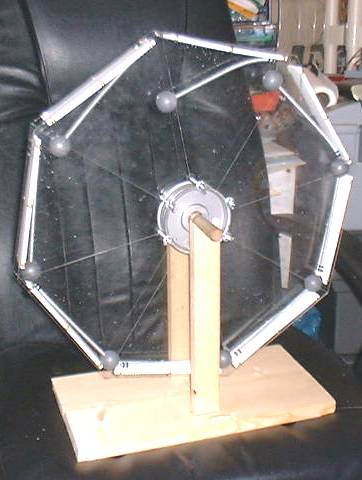
Gravity Motor - 19 rpm
Site at http://www.fieldlines.com/story/2003/5/6/1315/37395

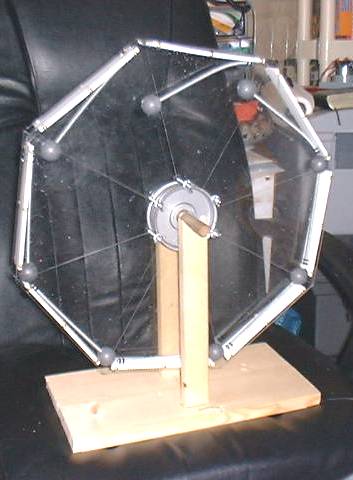
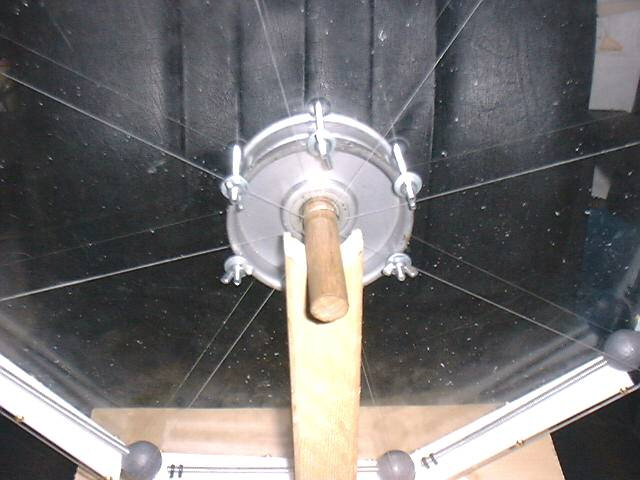

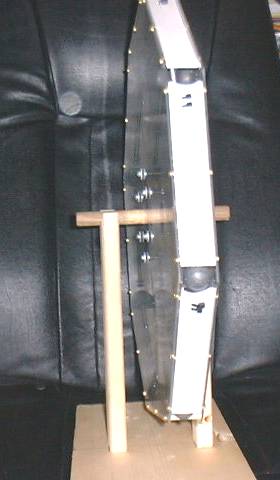
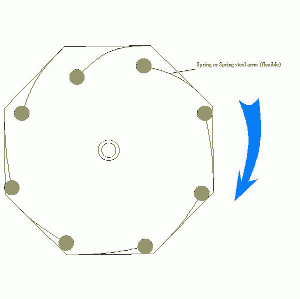
| I have found
that it may be easier for some to use pegs inside the wheel to stop the
inward motion of the spring weights at consistent points rather than the
lengthy process of tuning the springs to all flex the same! Springs just
flexible enough to reach the pegs and stay there until the moment required
to move outward to the periphery. Also, pay attention to the construction
details and homogenize all parts as to dimension and weights. I used 4oz.
lead balls and the 3/16" springs mentioned earlier. I am setting work upon
a seven segmented wheel as well which will be larger. This first wheel
measures 9" in radius as measured from hub center to center of each lead
ball at outer periphery. GOD bless all of you dear readers in Jesus Christ,
this day.
Peace, T.S. out |
Does it work?
(none
/ 0) (#2)
by Techstuf on Tue
May 6th, 2003 at 01:40:25 PM MST
(User Info)
| I am fairly certain that there is an appreciable number of individuals that already can and may prove it to you better than I can! This device is not as easy to duplicate as it might first appear, in that not all springs are created equal, I have found. Even those of the same type from the same manufacturer will vary. It took me some painstaking trial and error to match up the exact weights to get the consistent deviations in spring flex to all segments. In retrospect, I suspect that slightly softer springs of small variations in lateral tension strength would still work given that pegs be installed at consistent and fixed locations in the wheel to stop the arms from moving inward too far. This, I think would be better than designing the wheel around the measured bend distance of the spring arms at various locations around the wheel as I did. I used 4oz. lead balls, 3/16" O.D. springs found at a local Big Lots store that served as the long handles to magnetic pick up tools. As I look back at the circumstances relating to the way I received this idea and what has happened since, I am quite sure that it is GOD'S will that such simple exposition of such a device that goes against the supposed "laws" of science is released at this time! I am not the first, I know that. I am not the best, I know that. I am not really much of anything other than a follower of Christ, I KNOW that! This device is not mine but is for anyone that wishes to replicate it. I can already see many ways of improving upon it in various ways......but I am not even in the ballpark of what some of you "in depth" researchers may come up with! GOD bless all of you dear readers in Christ this day! There is yet time for the doubting and lost children of GOD to turn and follow GOD'S PERFECT LAWS which are already written on the hearts and minds of HIS children rather than man's imperfect "laws of science". Peace, T. S. out |
verification
(none
/ 0) (#5)
by Techstuf on Tue
May 6th, 2003 at 05:03:02 PM MST
(User Info)
This device is actuated by giving it a slight tip of the hand. It is turned off by stopping it by hand, as well. As I am no bessler, I have been able to obtain an RPM of only about 19. (Perhaps my bearing assembly is a bit robust for such a small model). I would expect this to improve in future models. I am leaving it to the young and impetuous brains out there to scale it up enough to get any useable power generation! The device's speed is self governing, it ramps up to speed quickly and simply stays there, although I have noticed some times if you start the wheel with too much impetus from your hand, it will sometimes "hiccup" in motion for quite some time afterwards. It may go right up to speed and then slow down and speed up until, it seems, that the extra energy from push starting it dissipates! I want to make clear that this device is NOTHING without the verification of replication. This is as simple a device as it gets in the Free Energy world, and for a GREAT and sobering reason! All this thing really is at this point, is a thorn in the side of physicists everywhere! How many of you know a single professor that laughed and ridiculed such a thing as this that would give a public apology for parroting the traditional heresy continually from his/her podium/pulpit! GOD bless, T.S. out
[in reply to the question: "why did you chose an eight sided wheel?"]
seven (none
/ 0) (#16)
by Techstuf on Wed
May 7th, 2003 at 12:21:29 AM MST
(User Info)
That is an interesting question! I cannot claim that I "chose" 8 sides. I made only what was revealed to my mind. For those interested in the numbers....the outer facets of the wheel are each 7 inches, that is to say, the extreme outer perimeter. Each white plastic slat that the springs are attached to are exactly 6 inches in length while the wheel's radius measures exactly 9 inches from hub center to the center of each lead sphere. The wheel is attached to the hub via a hexagonal arrangement of six 1/8 bolts with rubber washers and wing nuts as shown. I have an idea that a 7 sided wheel may perform even better! However I am not fully competent that this is the case. GOD bless, T.S. out